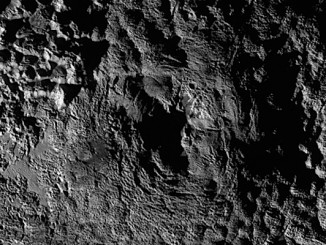Using three images beamed back to Earth from the New Horizons spacecraft’s long-range camera, scientists created this jaw-dropping animation of what it might look like to buzz Pluto from 25 miles up.
The animation includes two flyover scenes, first of a series of craggy ice mountains stretching more than two miles above their surrounding terrain. Scientists have informally named the mountain range “Norgay Montes” after Tenzing Norgay, the Nepalese sherpa who accompanied mountaineer Edmund Hillary on the first recorded summit of Mount Everest.
“What you’re seeing is a scene that’s about a total width about 250 miles across — 400 kilometers,” said Alan Stern, New Horizons’ principal investigator from the Southwest Research Institute. “These mountains soar as high above their local terrain as many of the mountains in the Rocky Mountains do here in the United States. “Pretty impressive.”
The second scene in the flyover is of Sputnik Planum, an enigmatic region near Norgay Montes covered with blocks of ice up to 20 miles across made of frozen carbon monoxide, and perhaps nitrogen and methane. Scientists are not sure what caused the shapes to form, but the ice field may come from convection bubbling up from Pluto’s warmer subsurface.
The flyover “gives you a feel for the scale of the fetaures that you’re looking at — really beautiful surfaces — and we’re going to be seeing a lot more of this,” Stern said. “This is 400 meters (1,300-foot) per pixel imagery. By next week, we’ll have more than twice as much as the three frames we’ve already been able to share.”
The three pictures sent to the ground as of Friday are just a sampling of hundreds of black-and-white and color images stored aboard New Horizons’ two solid-state data recorders.
Email the author.
Follow Stephen Clark on Twitter: @StephenClark1.



